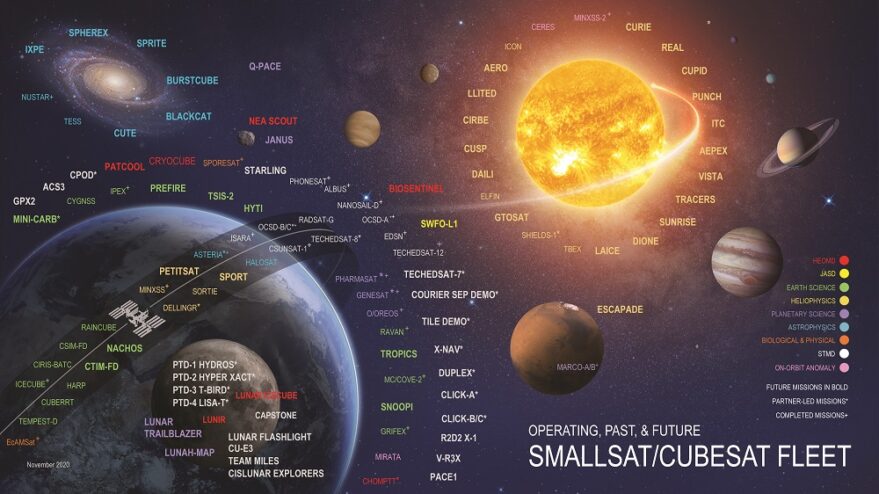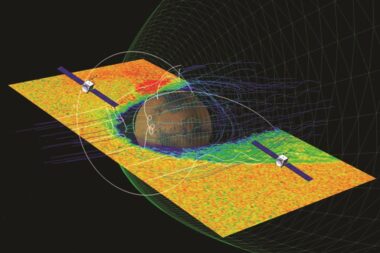Report calls for revamped cost-conscious vision for Mars exploration
By LDavid

With NASA’s Mars Perseverance rover ready to begin its multiyear mission to collect rocks and soil for future retrieval, planetary scientists are concerned other Mars research goals could suffer during the decade-long wait for those samples to complete their three-legged relay back to Earth.
With those worries in mind, NASA’s planetary science division chartered the Mars Architecture Strategy Working Group (MASWG) in 2019 to find ways to initiate a diverse set of Mars investigations alongside the flagship sample-return campaign without breaking the bank.
In November, the group delivered a final report to NASA that lays out an agenda for investigating Mars using a wide range of approaches meant to kick-start a higher cadence of scientific discovery at a sustainable cost.
Dubbed A Comprehensive Program for Future Mars Exploration, the report calls for chipping away at the Red Planet’s many remaining mysteries using everything from cubesats and commercial landers to top-shelf science probes.
Mars Sample Return remains the Mars science community’s top priority, as the report makes clear. But with no other Mars science missions in NASA’s pipeline, the narrow focus on collecting and retrieving several kilograms of rocks and soil from Jezero Crater could put wider investigations of the planet on hold for years to come.
“As important as Mars Sample Return (MSR) is — and it will result in a major step forward for planetary science — examination of material from a single site will not tell us everything that we need to know about Mars,” the MASWG report states.

Bruce Jakosky, the University of Colorado, Boulder, scientist who chaired the MASWG, said the report’s aim was to ensure the rest of the Mars Exploration Program doesn’t lose momentum while Mars Sample Return takes center stage for the rest of the decade.
“We’re at a point where it’s not clear what the Mars program is going forward,” Jakosky told SpaceNews. “There are no new missions that are being planned beyond sample return.”
Jakosky said the MASWG came up with a flexible, cost-effective plan for conducting a diverse mix of Mars science missions in parallel to the flagship Mars Sample Return campaign and beyond.
The report calls for a reinvigorated “new vision” for NASA’s Mars Exploration Program, one that includes a range of spacecraft sizes, from relatively inexpensive cubesats and constellations of small spacecraft, to more conventional, but low-priced, landers and rovers.
What’s more, the report’s authors say the plan leverages advances in cubesats, smallsat constellations and more to tackle key science questions without requiring more than roughly one-third of NASA’s annual planetary science budget — a share on par with what NASA has spent on Mars since the mid-1990s when it began sending new robotic explorers to the Red Planet every couple of years.
In writing their report, the 16-member MASWG team flagged small spacecraft as a “programmatic opportunity” for Mars and proposed a set of mission “arcs’’ that constitute high-priority and scientifically rich research that can be done during and after the present Mars Sample Return era.
As examples of exploration arcs for Mars, the MASWG report suggests:
Arc 1: Explore diverse environments of ancient Mars to understand early planetary evolution and the nature, timing, and geochemistry of environments, habitability, and/or biological potential of Mars.
Arc 2: Investigate the subsurface of Mars that hold many clues to the early evolution of Mars and the possibility of an early Martian biosphere.
Arc 3: Perform ice science measurements to understand Martian ice ages in terms of the distribution and stratification of ice as it was emplaced/removed over the last hundred million years, both in the polar regions and in lower latitudes.
Arc 4: Understand climate variability and processes of the current climate on Mars from hours to decades.
MASWG recommended bolstering the NASA Mars Exploration Program to address fundamental science objectives relating to the planet’s climate and geological evolution, past and present habitability, and more. It’s an agenda that’s not just pertinent to Mars. It could also profit NASA’s human exploration goals as well as the study of the solar system’s other terrestrial planets and exoplanets circling other stars, the report says.
Revamped Mars program
“If NASA and Congress are serious about Mars exploration and a humans-to-Mars program, we need to revamp the Mars program and continue it as a vigorous and robust program,” said Jakosky, the principal investigator for MAVEN, a 2013 Mars orbiter mission that’s still studying the planet’s atmosphere and will soon serve as a communications relay for Perseverance.
Jakosky said that the key message from the MASWG report is “figure out first what science you want to do and then select a size class of spacecraft that can do it. It’s a new world out there.”
The MASWG report also notes that there may be an avenue to work with commercial providers, or use contracting approaches derived from NASA’s Commercial Lunar Payload Services (CLPS) program to achieve lower cost access to the Martian surface. There’s also potential value in establishing collaborations between the many different governments and entities interested in Mars exploration, the report states.
Area for investment
“If there is one critical area for investment by NASA that is necessary to enable the MASWG approach, it is in small spacecraft and whether there are novel and lower cost ways to credibly explore the surface and subsurface of Mars,” said Scott Hubbard, a MASWG committee member and former director of NASA’s Mars program.
As for a “CLPS for Mars” program, Hubbard said while it is unclear if the business case for commercial deep space truly exists, “NASA would be well-served to test the waters via a Request for Information, or similar acquisition tool.”
Hubbard said that the MASWG report takes an instructive tack by outlining four mission arcs that demonstrate what new and exciting science might be accomplished using different types of exploration capabilities. “The MASWG team was quite conscious of the probable fiscal constraints in the next few years and so focused on beginning these arcs or pathways using small spacecraft,” he said.
Other mission arcs are certainly possible, the report points out, and the number and scale of arcs that can be pursued in parallel depend on available dollars.
Build, maintain and enhance
In mid-November, during a meeting of a National Academies committee working on the new planetary science decadal survey due out next year, MASWG co-chair Richard Zurek of the NASA Jet Propulsion Laboratory’s Mars Program Office emphasized the need to build upon the successes of NASA’s Mars Exploration Program and put it on a good footing for the future.
“It is the diversity of the planet that we’ve seen over the last two decades,” Zurek said. “We have to find a way that we can get down to the surface and learn some key things and not have it cost one to two billion dollars.”

Due to the complexity and varieties of environments that exist on Mars, Zurek said that NASA should support missions that do more than what a sample return campaign from a single point on the planet can provide. For instance, helping pin down ice deposits on Mars that can be used as a resource to support human activity on the planet. Then there’s the question of what the subsurface of the planet may yield. “The subsurface, after all, may be the final refuge of an early Mars biosphere. There may be water very deep in the crust,” Zurek said. “We still have much to learn.”
Zurek said having a sufficient number of flight opportunities is important to sustain the technical and analytic capabilities of the Mars science community. More frequent opportunities may also be essential to attract the commercial sector and maintain international partnerships in Mars exploration.
“Start small and go big as the science dictates,” Zurek said.
Rough cost estimate
The full Mars program outlined by MASWG would cost around $300 million a year during the first decade, ramping up to $500 million a year beyond that. An additional $150 million a year, the report says, would be needed for technology development and funding extended missions.
Jakosky said that a less-robust but still compelling suite of missions could be implemented for $150 million per year in the first decade, ramping up to $300 million per year after that.
These rough estimates, which Jakosky said were based on “simple assumptions” rather than a formal cost analysis, don’t include what NASA already plans to spend on Mars Sample Return or extended operations for several aging spacecraft already studying the planet.
Critical juncture
Other than Mars Sample Return and a planned Mars Ice Mapper mission to be funded by the agency’s human spaceflight division, NASA does not have any directed Mars missions in its pipeline for development in the decade ahead.
“It was recognized that the science to be done in exploring Mars is more than waiting for samples to return to Earth,” said Michael Meyer, lead scientist for the Mars Exploration Program at NASA Headquarter and ex officio for the MASWG report.
Should the Mars 2020 mission’s Perseverance rover not make it safely to the surface during its Feb. 18 landing attempt, the wait would be even longer.
“The loss of Perseverance would be devastating,” Meyer told SpaceNews. “Individual careers would be turned upside down. There is no backup plan, meaning there are no makeup missions in the wings.”
If Perseverance crashes, Mars would still be there — mysteries intact. “There will still be many scientifically compelling missions to do at Mars and sample return would still be of the highest priority,” Meyer said. “The ramification of the mission loss would not be science lost but science postponed. The setback would be time and money, but the goals of exploration would be the same.”
While NASA does not have a formal backup plan, it now has the MASWG report’s vision for a Mars Exploration Program that does not put all of its scientific eggs into one sample-return basket.
“Scientifically, Mars exploration does not stop with Mars Sample Return,” Jakosky said. “There are truly fundamental and compelling measurements to be made that will advance our understanding not just of Mars but of the rest of the solar system and beyond.”
Jakosky said now that the report is done, it’s up to NASA to decide if it wants a Mars program that’s more than just sample return.
“We’re at a critical juncture. Now is the time to make decisions or we lose the momentum that we have built up over the past decades,” he said.
Maintaining that momentum is about more than tackling questions mostly of interest to planetary scientists. If NASA intends to send people to Mars in the near future, Jakosky said,“then there needs to be a continuing Mars program in order to answer questions about the environment that astronauts will face and to ask questions that astronauts can address with a human mission.”
The Mars Architecture Strategy Working Group (MASWG) final report is available at: https://mepag.jpl.nasa.gov/reports/ MASWG NASA Final Report 2020.pdf
SpaceNews contributor Leonard David is the author of “Moon Rush: The New Space Race” published by National Geographic in May 2019.
A version of this article originally appeared in the Jan. 18, 2021 issue of SpaceNews magazine.
February 18, 2021 at 06:08PM
via SpaceNews read more...

Post a Comment